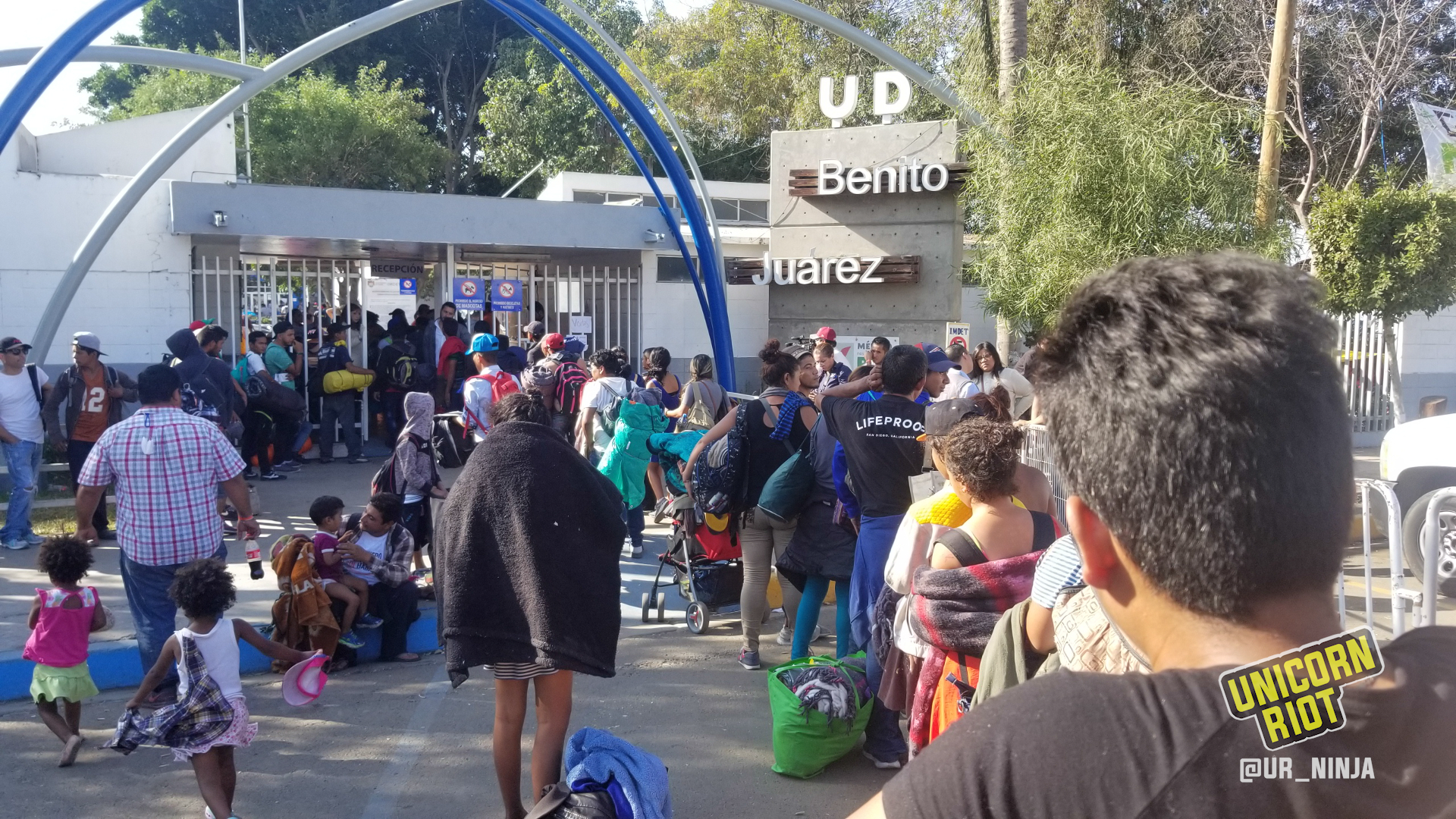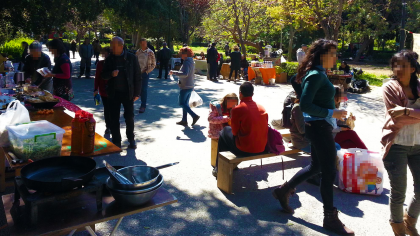Asylum Seekers from Caravans Gather Along U.S./Mexico Border
Mexico/U.S. Border – Unicorn Riot sent a team of two that spent five days from November 15 to 20, 2018 along the United States/Mexico border south of San Diego, California as caravans of asylum seekers arrived in Tijuana, Mexico. We witnessed coils of razor wire strung across the border wall and saw a mix of armed law enforcement officers in military looking uniforms watching the border.
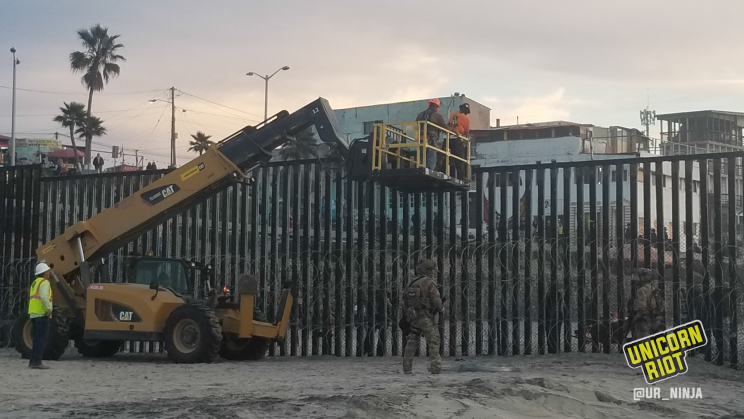
One of our team, Lorenzo Serna, crossed into Tijuana, Mexico, and documented an anti-migrant march as it attempted to move into the caravans housing center. However, the march was stopped by Mexican police forces. While in the cramped unsanitary housing center, Unicorn Riot spoke to a few refugees from Honduras and Guatemala about their journeys.
Below we’ve included a day-to-day diary from our time there which includes: embedded photographs, videos, and hours of recorded livestreams.
November 15, 2018 – We arrived early in the morning at the United States/Mexico Border. We already had heard that thousands were arriving on the Tijuana side of the border and knew that a small group of LGBTQI asylum seekers who came in the caravan were already there. We’d seen pictures of them climbing to the top of the wall, their hands raised in victory. These images were followed by stories of rocks thrown at them as they slept near the wall on the Tijuana side.
The events from the pictures of the people climbing on the wall occurred at Border Field State Park, at the southwestern corner of the United States. We arrived there, grabbed our equipment, and began the mile and a half trek through the soft sand. North of us was a Navy airfield where military helicopters performed some sort of all-day circular ballet of landing training. I watched them dip and bob as we walked, and kept thinking about recent attacks on LGBTQI migrants in Tijuana, and the right-wing rhetoric spreading fears of an invading force in the United States. When we got to the border wall, Coast Guard and Department of Homeland Security choppers traversed the skies.
Along the wall itself, a construction crew strung razor wire across the top; the silver flashed like tinsel in the setting sun. Border Patrol officers in battle dress uniforms (BDUs) held suppressed AR-15 variants with holographic sights as they watched over the new construction.
We saw people milling around on the Mexico side of the fence, moving closer to talk to the Border Patrol officers. We weren’t allowed to hear the discussion because on the United States’ side, a twenty-yards-wide swath of land between California and Mexico belongs to the federal government, and at least for tonight the US government wasn’t letting us closer to the wall.
We spent hours at the wall troubleshooting data issues as we spoke to onlookers who came to see if “it was really going on,” as one man put it (“it going on“, being the thousands of people arriving in a caravan from Honduras, many seeking asylum in the United States.)
We’d arrived following the near-frantic news reports regurgitating quotes from a U.S. president willing to broadly paint people as gang members and murderers; this rhetoric soon crossed over into the Tijuana news and out of the mouths of the mayor and locals.
November 16, 2018 – Similar to the day before, we spent time watching the continued construction and the small pockets of people on the other side move towards the wall, then away. We were told that thousands had arrived on the other side, but on the U.S. side, the only way you can tell anything was going on was by the construction crew continuing to fortify the border, with armed guards looking on. We left the beach that evening after being told by Border Patrol that we weren’t allowed in the park after dark.
As we were wrapping up our second day of reporting from the United States side, we ran into a woman who’d sprinted around the parking lot of the state park. She came over to us and said, “They’re doing it. They’re invading. I just talked to the Border Patrol and he said they’d never seen so many, they’re gonna flood over. They used the word ‘flood!’”
I stood on the doorstep to our van and tried to see through the darkness and hills to the wall. We’d just been told we weren’t allowed back and we weren’t able to see the wall along the beach. If they were “flooding” over, the only non-U.S. government witnesses would be from the Tijuana side. We waited and watched as helicopters flew along the border line. Then everything went quiet. I played over the last couple days and the stark contrast of media noise to the recent memory of the sounds of the ocean lapping at the iron spikes of the wall.
Border Patrol Tells All Reporters to Leave US/Mexico Border Area from Unicorn Riot on Vimeo
November 17, 2018 – I crossed to the Mexican side of the border and got into a cab and asked to be taken to the “playas.” The driver, like most people I spoke to, wanted to talk about the caravan. He told me he knew “they were all gangstas“. I asked him how he knew this was true about everyone in the caravan, and he just said he knew. When I got to the fence, I went down to the beach and stood on the Mexico side of the border. I touched the steel of the wall and wondered how deep they’d have to be anchored to hold in a constantly shifting sand.
The beach is overlooked by a boardwalk lined with small restaurants, most selling seafood. The beach itself was near empty at 8 p.m. when I arrived. I walked the border fence and ran my hands along the iron bars that had been stabbed into the Earth. I walked away then, back up to the wall, and I tried to imagine what it would be like to come so far, through so much, to this wall of steel patrolled by masked uniformed people holding guns on the other side.
I waited for a few hours, but no mass of people appeared, and the sun set as a wedding party laughed and walked through the surf.
November 18, 2018 – I was back in Tijuana trying to meet up with an anti-discrimination march. There was also a right-wing march against the caravan. I took a cab and gave him the address to the march against violence and discrimination. Halfway there, he asked me where I was going. When I told him I was heading to the march about the caravan, he replied that the march was “over here,” and he dropped me off at the march against the caravans. I checked my GPS and walked the eight minutes to the march against violence.
When I got near the streets, I saw a few people holding signs that stated to “stop the violence against the migrants,“ and that “babies have no borders.“ Down the street, the march against the caravan waved Mexican flags, and people numbering in the hundreds shouted for everyone to go home. I walked back and listened as they shouted, “Mexico First! Tijuana for Tijuana.“ We’d heard that there was a wave of nationalism taking over Tijuana, bleeding over from across the border. Here it manifested.
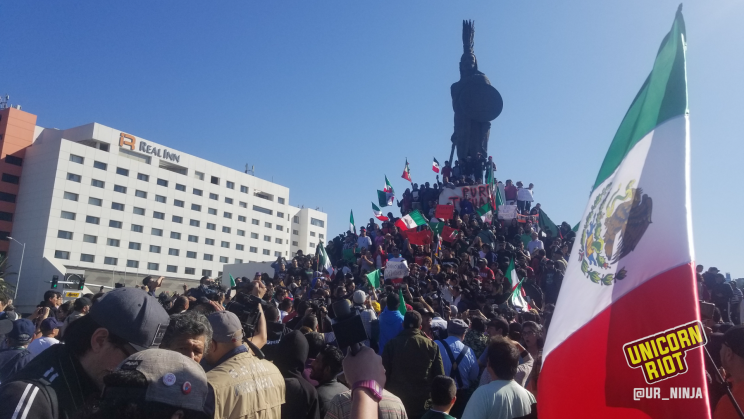
I watched as people mobbed a person who had started speaking in the middle of them in support of the caravan. She was pushed out and attacked. She was led out by Mexican police officers who held the anti-migrant protesters at bay. I followed, trying to hear what she was saying. She said that the world had to change, that these nations were colonial projects, that everyone was going to be okay. She said indigenous people just had to believe in the prophecy of the Eagle and the Condor.
I rejoined the march and they moved, waving Mexican flags and shouting anti-migrant chants as they went towards the stadium where the migrants were housed. The march was stopped by Mexican riot police who held a line against the march, whose participants pleaded and pushed to be let into the stadium. I sat behind the police line trying to imagine what the march would do if it reached the stadium. What else did they really plan to do?
I left the march and went into the Benito Juarez Stadium where thousands of people waited. I entered, signing in as press and was given an hour to walk the grounds and talk. I walked the stadium and saw children darting around. I saw mothers, fathers, and people of every age and gender all in this place. I sat in the middle of a field and some people walked up and sat next to me.
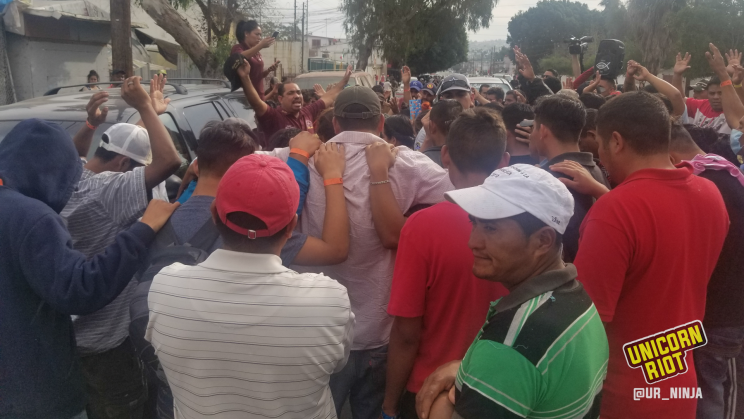
I asked them why they came, and one of the men told me that in Honduras his five co-workers had been murdered, and that he was going to be murdered next and he had to leave, that he can’t go back, anywhere but back. Another person sat next to me and looked back towards where the anti-migrant march was, he asked, “¿Nos quieren matar?” (“They want to kill us?“) then he pointed north to the United States, and he said the same, “¿Nos quieren matar?” (“They want to kill us?“) He looked down and shrugged. Another man said they just want to be treated with dignity, not left in misery. I left that day watching as pastors prayed over huddled masses of Christians from Central America.
November 19, 2018 – As rhetoric on far-right channels reached a fever pitch about the “invading” migrants in Tijuana, at the camp thousands waited, lined up in different queues. Volunteers talked to the groups about the process to apply for asylum and the process to get a work visa in Mexico. Everywhere there was paperwork and an unfolding stasis, as migrants waited for what was next. I walked through the camp, and people taking shelter there asked me for information, but I knew little.
The border was closed for an hour in the morning, as the United States moved barriers and put up more razor wire. In the camp, they were asking what happened. Is the border closed? Can I still go apply for asylum? I passed a line of port-a-potties that smelled of sewage. Over at the entrance to the stadium in Tijuana, more people got moved in, registered, and tried to find space for their tents. Others just threw a blanket down and slept.
November 20, 2018 – The scene was roughly the same: more people showed up from the caravans, more health facilities were set up, and the lines grew longer. Down the street a few Mexican Marines in battle dress uniforms held battle rifles, looked away from the camp, and scanned for something.
I moved through the area, taking pictures. Men, women, children, elders, youth all milled around, constructing what little private space they could; blankets over strings, little shelters with space for one or two people, were built between the stadium bleachers.
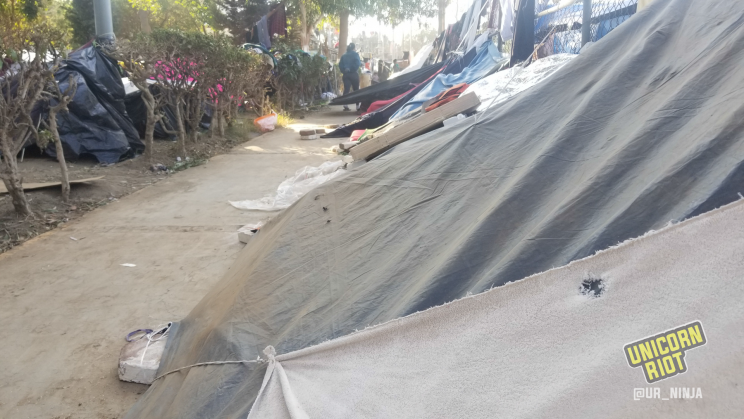
A man tells me they are impatient; they’ve been here six days and he’s been told it could be a month before his asylum case is heard. In the U.S. some troops are being withdrawn, but on the other hand, the President has authorized the use of deadly force for those soldiers left behind. Trump has also threatened to close the border.
On the ride out, the cab driver talked about the ten thousand more people coming. I said yes, and that more people will soon be shoved into that little space. A lot of journalists and outsiders asked me what I would do… What would you do? What’s the solution? I only answered once and said that there was no solution in this world… not in a world organized like this. There isn’t a solution for what’s coming.
Already, Mexican nationalists have marched on the camp and threatened the people taking refuge there. The camp itself appeared limited in its capacity, as thousands more are expected to arrive in caravans. In the United States the President enacts executive orders against the asylum seekers and is countered by the courts. Private US militias patrol the border while white nationalists and supremacists in the U.S. continue to threaten violence against the caravans, all while immigration rights activists and sanctuary movement activists head to the border to support the thousands more people on their way.
Please consider a tax-deductible donation to help sustain our horizontally-organized, non-profit media organization:

Unicorn Riot's Coverage of the Asylum Seekers at the US/Mexico border:
- Military and Militias Deploy to US/Mexico Border to Confront Caravan of Asylum Seekers (Nov. 8, 2018)
- Asylum Seekers from Caravans Gather Along U.S./Mexico Border (Nov. 23, 2018)
- Tear Gas at Border as Asylum Seekers Attempt to Cross (Nov. 26, 2018)
- Migrants Speak as Thousands Continue to Arrive (Nov. 28, 2018)
- Migrants Moved to New Center as Hunger Strike Continues (Dec. 3, 2018)
- Border Patrol Arrests Migrants Crossing U.S./Mexico Border Wall (Dec. 4, 2018)
- Hunger Strike Ends with March on U.S. Consulate (Dec 11,2018)
- Faith Leaders March on U.S. Border in Solidarity With Migrants (Dec 13,2018)
